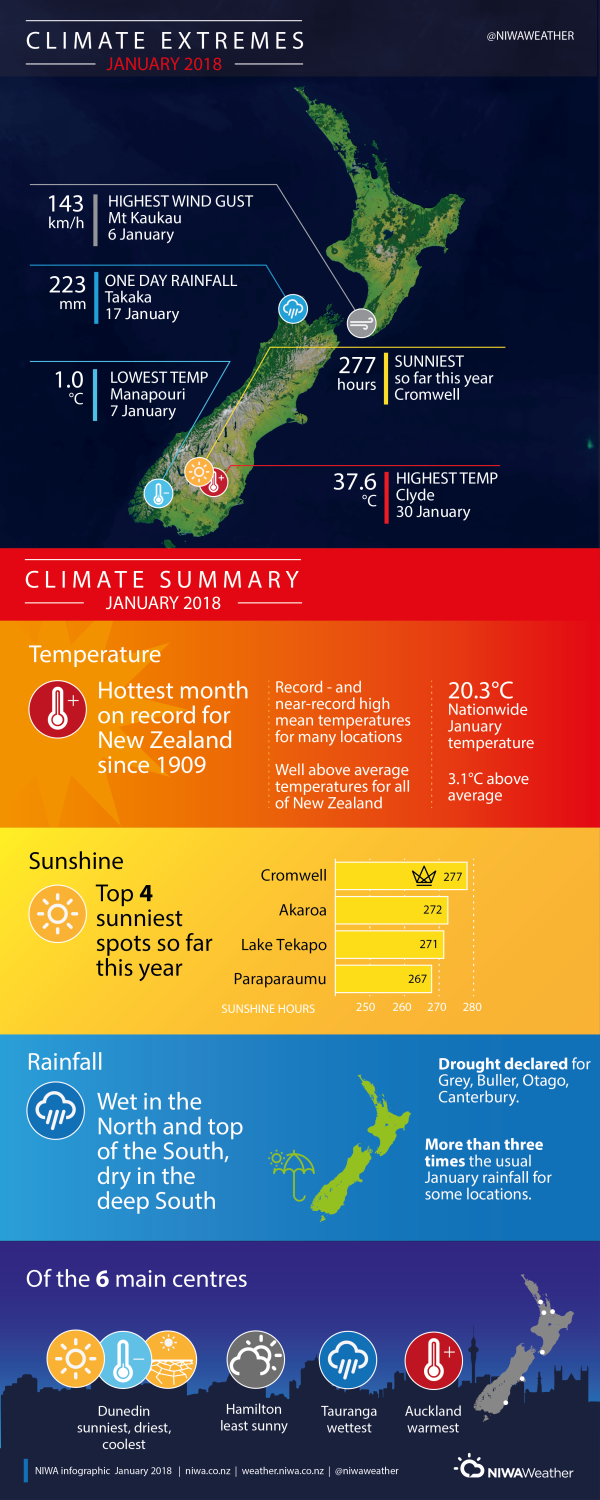New Zealand’s hottest month on record
Temperature: Exceptional record-breaking warmth
January 2018 (New Zealand mean temperature 20.3°C; 3.1°C higher than the 1981-2010 January average) was New Zealand’s hottest month on record, which of course means it was additionally the country’s hottest January on record. The previous hottest January was observed in 1956, when the mean temperature was 19.0°C (1.9°C higher than the 1981-2010 January average). January 2018 is the fourth month in the 21st century to have a nationwide temperature more than 2.0°C above average (after February 2016, May 2016 and December 2017).
Temperatures were well above average (>1.20°C of average) for the entire country, and locations in every region recorded either their record or near-record January temperature on record. Notably, Christchurch and Hokitika observed their hottest January since records began in 1863 and 1866, respectively. Gore’s mean temperature for January 2018 was 19.2°C (4.8°C higher than its January average); which is equal to the average daily maximum temperature for January in the town.
Record or near-record high mean maximum (daytime) and mean minimum (night-time) temperatures were also observed in every region of the country. Mean maximum temperatures for January 2018 were highest about Central Otago, where Cromwell and Clyde observed maximum temperatures above 30°C on 21 and 20 days, respectively. On average, these towns would usually observe 6 days above 30°C in an entire year.
Overview
January 2018 was characterised by higher than normal sea level pressure to the east of New Zealand, and lower than normal sea level pressure to the west of the country. This pressure setup delivered more northerly-quarter winds than normal. Sea surface temperatures (SSTs) in New Zealand coastal waters and the Tasman Sea remained considerably higher than normal throughout the month.
The combination of more frequent northerly-quarter winds and higher than normal SSTs had a profound influence on air temperatures observed throughout the country during January. The nationwide average temperature in January 2018 was 20.3°C (3.1°C above the 1981-2010 January average from NIWA’s seven station temperature series which began in 1909). January 2018 was the hottest month on record for New Zealand using the seven-station series, surpassing the previous record of February 1998 when the nationwide average temperature recorded was 19.6°C. The exceptional and persistent warmth during the month meant mean temperatures were well above average (>1.20°C of average) throughout New Zealand. Notably, over half of New Zealand’s regularly reporting stations observed mean temperatures at least 3°C above their January average.
January was a contrasting month for rainfall, as relatively few observation stations recorded near normal rainfall overall (80-119% of normal). The predominant northerly-quarter airflows delivered a steady stream of relatively humid air over the country. This combined with strong daytime heating to cause frequent convective (relatively short-duration, high intensity) rainfall events, particularly over inland parts of the North Island. In addition, several low pressure systems brought periods of persistent rainfall, particularly to northeastern parts of the North Island, Nelson and Tasman Districts. Rainfall was above normal (120-149% of normal) or well above normal (>149% of normal) throughout much of the top half of the South Island, and in many areas of the North Island. It was an exceptionally wet month in Christchurch and the Tasman District, where rainfall was more than three times higher than normal for January. In contrast, southern and inland parts of the South Island were relatively sheltered from the humid northerly-quarter airflows, and observed a relatively dry month as a result. Below normal (50-79% of normal) or well below normal (<50% of normal) rainfall was observed throughout Southland, parts of Otago, Mt Cook and Arthur’s Pass. Rainfall was also below normal for coastal parts of Hawke’s Bay.
By the end of January, soil moisture levels were below or well below normal for the time of year across many southern and western parts of the South Island. This was largely due to a relative lack of rainfall and exceptionally warm temperatures observed in these areas. Notably, the Government announced a medium-scale adverse drought event for the Grey and Buller Districts on 10 January. This drought classification was extended to include Otago and Southland on 30 January. Soils were also drier than normal for the time of year for many eastern and southern parts of the North Island, as well as Taranaki. Soil moisture levels were above normal for eastern parts of Northland, Auckland, Bay of Plenty and Nelson. Meanwhile, soil moisture levels were typically near normal for the time of year for remaining parts of the country.
Further highlights:
- The highest temperature was 37.6°C, observed at Clyde on 30 January.
- The lowest temperature was 1.0°C, observed at Manapouri on 7 January.
- The highest 1-day rainfall was 223 mm, recorded at Takaka on 17 January.
- The highest wind gust was 143 km/h, observed at Mt Kaukau (Wellington) on 6 January.
- Of the six main centres in January 2018, Auckland was the warmest, Dunedin was the sunniest, driest and coldest, Tauranga was the wettest and Hamilton was the least sunny.
- Of the available automatic sunshine observation sites, the sunniest four locations in 2018 so far (1 January – 31 January) are Cromwell (277 hours), Akaroa (272 hours), Lake Tekapo (271 hours) and Paraparaumu (267 hours).
Contact
Gregor Macara, Climate Scientist Tel. 04 386 0509
Download:
- January 2018 Climate Summary information [PDF 800KB]
- January 2018 Climate statistics [PDF 90KB]

